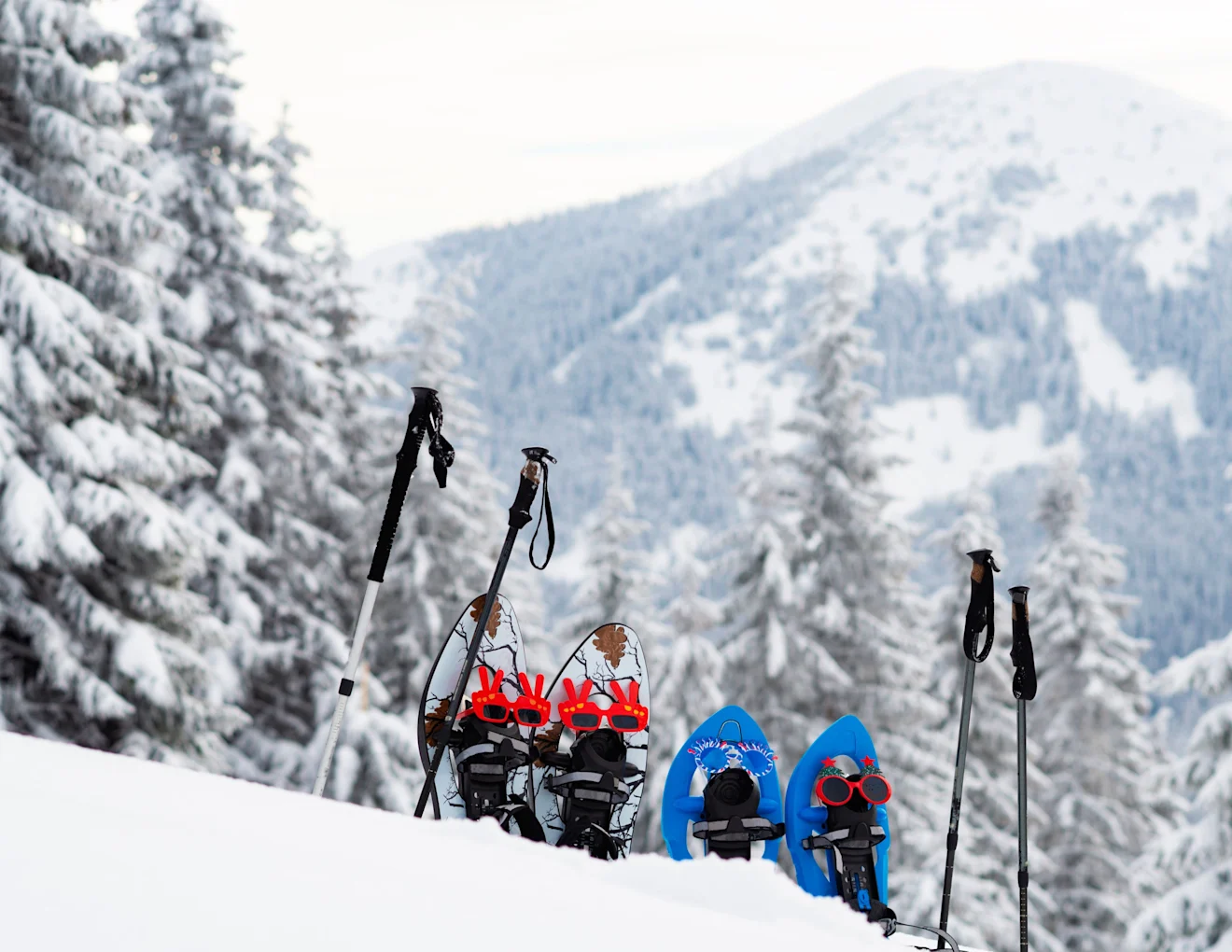Snowshoeing is one of the most accessible and enjoyable winter activities, offering a unique way to explore serene, snow-covered landscapes while staying active. Whether you’re trekking through a quiet forest or scaling gentle slopes with panoramic views, snowshoeing allows you to experience winter’s beauty in an entirely new way.
This beginner-friendly guide covers everything you need to know about snowshoeing, from choosing the right gear to mastering basic techniques and staying safe on the trail. With the right preparation, snowshoeing can be a fun and rewarding way to embrace the colder months.

Choosing the Right Gear
Before you step into the snow, having the right gear is crucial for a comfortable and enjoyable snowshoeing adventure.
Types of Snowshoes
The type of snowshoe you choose depends on the terrain you plan to explore. Recreational snowshoes are ideal for flat or rolling trails, offering lightweight frames and basic traction. For steeper or more rugged terrain, backcountry snowshoes with aggressive crampons and durable materials provide better grip and stability. If you’re looking for something more specialized, running snowshoes are designed for speed and agility on packed trails.
Sizing and Fit
Snowshoe sizing depends on your weight, including any gear you’re carrying, as well as the type of snow. Larger snowshoes provide better flotation in deep, powdery snow, while smaller snowshoes are easier to maneuver on packed trails. A snug, secure binding ensures you stay comfortable and stable throughout your hike.
Footwear and Clothing
Waterproof hiking boots are a must, as they keep your feet warm and dry even in deep snow. Pair them with moisture-wicking socks to prevent blisters and keep your feet comfortable. Dress in layers, starting with a base layer to wick away sweat, an insulating mid-layer for warmth, and a waterproof outer layer to protect against snow and wind.
Optional Accessories
Poles with snow baskets provide added stability, especially on uneven terrain. Gaiters are another useful addition, preventing snow from entering your boots. Finally, a daypack is essential for carrying water, snacks, navigation tools, and extra clothing layers.

Basic Snowshoeing Techniques
While snowshoeing is easy to learn, mastering a few basic techniques can make your experience smoother and more enjoyable.
Walking in Snowshoes
Snowshoes require a slightly wider stance than regular walking to avoid stepping on your own frames. Focus on a steady “heel-to-toe” stride to maintain balance and move efficiently through the snow.
Climbing and Descending
When tackling uphill sections, dig the toe crampons of your snowshoes into the snow to gain traction, and use trekking poles for extra stability. On downhill slopes, lean back slightly and allow your heels to sink into the snow for better control.
Turning and Maneuvering
Turning around on narrow trails can be tricky. Use small, deliberate steps to pivot your body, and keep your poles planted for balance. With practice, you’ll find these movements become second nature.

Planning Your First Snowshoeing Adventure
Choosing the right trail and preparing thoroughly are key to an enjoyable first snowshoeing trip.
Choosing a Beginner Trail
Start with a marked, groomed, or flat trail to get comfortable with snowshoeing. Resources like AllTrails and the Washington Trails Association (WTA) provide trail recommendations and recent conditions, making it easier to select a route that suits your skill level.
Trail Etiquette
Respect other trail users by staying on designated paths and avoiding cross-country ski tracks, as they are easily damaged by snowshoes. Yield to faster trail users and step aside when necessary to allow others to pass.

Understanding Trail Markings
Snow can obscure trail signs, so familiarize yourself with common symbols and safety markers before heading out. If in doubt, use a map, GPS, or navigation app to stay on course.
Snowshoeing Safety Tips
Safety is paramount when venturing into snowy terrain.
Weather Awareness
Check the weather forecast and avalanche conditions before heading out, especially if your trail is in or near a backcountry area. Avoid snowshoeing in extreme weather or during high avalanche risk.
Carrying Essentials
Pack a small first aid kit, navigation tools such as a map and compass, and extra food and water. Staying hydrated is just as important in cold weather as it is in the summer.
Avalanche Safety
If you plan to explore backcountry trails, familiarize yourself with avalanche safety basics. Carry essential tools like a beacon, probe, and shovel, and know how to use them.
Hiking with a Buddy
Always snowshoe with a partner or group. Not only is it safer, but it also makes the experience more enjoyable. If you must go solo, inform someone of your route and expected return time.

Common Mistakes to Avoid
Even experienced snowshoers can make mistakes, so here are a few common pitfalls to watch out for.
Underestimating the Trail
Start with short, beginner-friendly trails and gradually work your way up to more challenging routes.
Wearing Cotton
Cotton clothing retains moisture, which can lead to discomfort and even hypothermia. Stick to synthetic or wool layers that wick away sweat and provide insulation.
Neglecting Hydration
Cold weather can mask signs of dehydration, so make it a point to drink water regularly. Bring an insulated bottle or thermos to keep your drinks from freezing.
Ignoring Rest Periods
Snowshoeing can be more physically demanding than regular hiking, so take short breaks to catch your breath and enjoy the scenery.
Snowshoeing is a fantastic way to embrace winter and explore the beauty of the snowy outdoors. By choosing the right gear, practicing basic techniques, and prioritizing safety, you’ll be well on your way to enjoying this rewarding winter activity.
Ready to get started?
